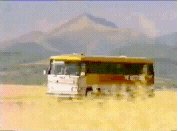
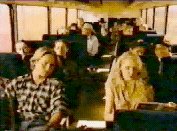
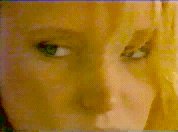
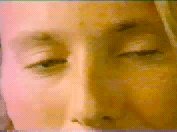
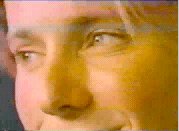
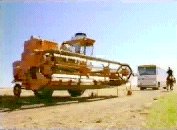
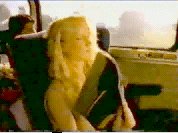
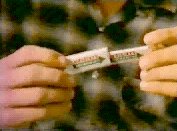
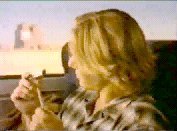
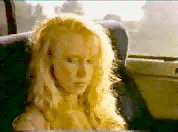
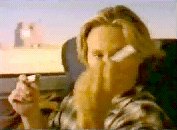
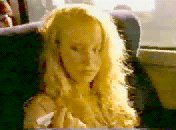
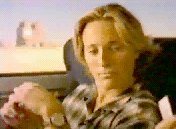
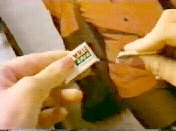
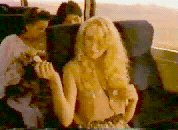
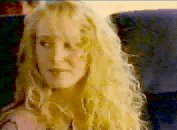
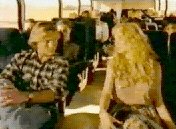
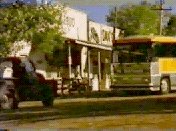
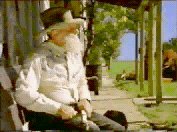
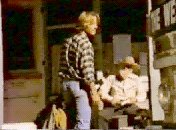
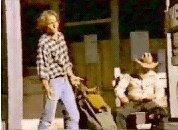
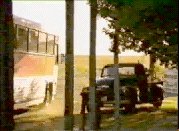
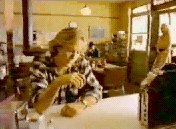
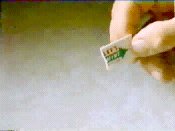
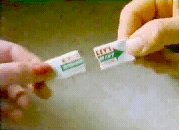
Voice-over (male): 'Cool, refreshing Wrigley's Spearmint gum'
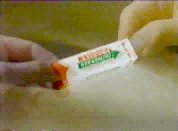
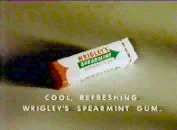
This short commercial can serve as the basis for your own attempt at semiotic analysis. You may use my own online text as a framework for this analysis - see:
Additional reading is included below. You may also wish to search the Web for any relevant background information about the Wrigley company.
The commercial can be downloaded from here (access is solely for students on this module).
Here is a shot-by-shot breakdown of the ad...
| Shot number | Screen image | Audio/text | Summary
| 1
| 
Rock music ('All Right Now' by Free, 1970)
| Long-shot of coach moving through prairies full of ripe wheat.
Bright sunlight, mountains in background.
| 2
| 
| Cut to internal shot. View from front of coach looking towards back.
The only two passengers in full view are a young white woman on RHS, shoulder-length
blond hair, young white man on LHS seat wearing check shirt, open at collar.
| 3
| 
| Close-up as she glances at him.
| 4
| 

| Reaction close-up as he returns the glance, then turns away smiling
| 5
| 
| Cut to external shot. The moving coach is framed between a combine
harvester (filling the foreground) and a man on a horse to the RHS.
| 6
| 
| Cut to internal scene. Focus on girl who leans back into seat using
newspaper as a fan.
| 7
| 
Voice-over (male): 'Wrigley's Spearmint Gum...'
| Close-up on the young man taking a stick of gum out of a packet.
| 8
| 
| He turns to his right (away from camera) to look at apparently empty packet.
| 9
| 
| She glances across.
| 10
| 
'...great to...'
| He turns to her and offers her the stick of gum.
| 11
| 
'...chew...'
| She takes it.
| 12
| 
'...even...'
| Shot of him looking across.
| 13
| 
'...better to...'
| She tears the stick of gum in two.
| 14
| 
'...share...'
| She offers him one half.
| 15
| 
Lyrics (male voice): 'Now don't you way-ay-ait...'
| She smiles at him.
| 16
| 
'...or...'
| Both lean toward each other. She looks at him. he looks forward, smiles,
adjusts his position.
| 17
| 
'...hesitate...'
| Coach pulls up at café.
| 18
| 
'...Let's move...'
| Shot of man with white beard and large hat sitting by entrance. He is
whittling a stick and looks up.
| 19
| 

'...before they raise the parking rate...'
| Shot of the young man who was on the coach walking past the old man.
Young man turns to look at the coach, bends slightly sideways, raises and lowers his shoulder.
| 20
| 
'...oww...'
| Coach starts to move away.
| 21
| 
'...All right...'
| Shot inside café. Young man at bar, holding wrapper in one hand, staring at
counter. Girl enters behind him at doorway RHS.
| 22
| 

Lyrics: '...now, baby... it's uh all right...'
| Voice-over (male): 'Cool, refreshing Wrigley's Spearmint gum' Cut to close-up of hand on top RHS, joined by hand at bottom LHS as the two
halves of gum are brought together. The nails on the hand on LHS are longer and are manicured.
| 23
| 

Text (in caps): 'COOL, REFRESHING WRIGLEY'S SPEARMINT GUM'
| Fade-in of captioned photo of Wrigley's Spearmint Gum
| |
Here is Guy Cook's semiotic analysis of the 'Last Stick' commercial...
|
Many ads create powerful and complex messages entirely - or almost entirely - through pictures and music, and are virtually language-free. In illustration of this, I shall examine one such ad in detail.
This is 'Last Stick', a TV and cinema ad from 1990-1 for the internationally best-selling chewing gum Wrigley's Spearmint... It... is a narrative... but it is not for its skill in compressed story-telling that I wish to analyse it here. The tale unfolds to the music of 'All Right Now', a pounding pop song of 1970 (successfully re-released at the same time as the ad). Though the words of this song also concern a meeting between two strangers, I shall treat this ad, its message and its methods as fundamentally non-verbal, as I believe they are, though I also briefly refer to the mood of the song in the analysis. In order to discuss the significance of the different images used, I shall first need to give an outline of the story. The ad begins with a broad panoramic shot of a bus - 'The Westerner' - making its way in bright sunlight past high mountains through prairies full of ripe wheat... The camera shifts to the interior of the bus where a young man and a young woman sit across the aisle from each other, on the inner seats... Both are blond, white, conventionally good-looking. They are clearly attracted to each other, but shy. She glances at him, but as he looks back she looks away. Behind the couple, we glimpse the other passengers: a Hispanic couple (the woman holding a bunch of flowers), another white couple, an older 'country couple' (the man wearing a cowboy hat). There are alternating close-up shots of the young man and young woman... She is reading a magazine. She looks at the young man again. He looks away, out of the window, but seems pleased. The scene shifts back to the prairie outside: telegraph wires along the road, distant mountains, a heat haze. The next shots are extreme close-ups - just the eyes and nose of each main character in turn... He glances sideways; she looks back. The scene changes back to the exterior again: a combine harvester, a man on a horse riding past in the other direction. Back inside, the young woman is fanning herself with her magazine. The young man reaches into the pocket of his shirt. We see a close-up of his hand taking out a packet of Wrigley's Spearmint Gum. He takes out a stick of gum and then looks back into the packet. It was his last stick. He hesitates - then offers it to her and she accepts. From the seat in front, a small boy looks round curiously, until the hand of the invisible adult beside him descends firmly on to his head and twists him back towards the front. We return to the young woman who is reading the Wrigley's wrapping paper. The camera shows her hand in close-up as she breaks the stick in half, and offers one half back to the young man. There are alternating shots - again very close - of the two main characters looking affectionately towards each other. In a longer shot of the interior of the bus, she shifts her body closer towards him. He does the same. The bus stops outside a building called 'The Rosebud'. Outside, there is a van parked and a horse tethered, a cartwheel leaning against the wall. An 'old-timer' with a large white beard is sitting on the porch whittling a piece of wood. The young man is leaving the bus. He turns and raises his hands in a gesture of resignation. We see the young woman's face close up. She looks down sadly. Inside, the young man sits down, while outside the bus pulls away. As the young man sits dejected, the young woman enters behind him. She has got off the bus to be with him. The final shots show his hand with half a stick of Wrigley's gum, and her hand with the other half. The two halves join and fit perfectly; they merge into one, then transform into a whole, full packet. Words appear on the screen:
A male voice says: 'Cool, refreshing Wrigley's Spearmint Gum. Great to chew. Even better to share.' The hands disappear, and we see the packet on its own. In this ad, there are four distinct pictorial perspectives. There is the broad sweep of the outside world of nature - sunlight, corn, mountains - a benign, fertile, agricultural world at harvest time, in which the traditional (horses) and the new (combine harvesters) are in harmony. Moving in more closely, there is the social world of the bus and the bus station. This too is harmonious, with a cross-section of American society: the old man and the little boy, the rural couple, different races. Moving in even more closely, there are shots in which we see the young man and woman, within this social context, forming a relationship. Lastly, closest in of all, we see their faces from so short a distance that the image is one of complete intimacy. Only in an embrace would one see someone so close. The most dominant image is the middle perspective: the young man and young woman forming their relationship in a social context. The overriding impression, then, is of a young man and woman meeting in a beautiful landscape, as part of a harmonious and approving society. It is also a very American world: the prairie, the old-timer, 'The Rosebud' (the same name as the sled which symbolizes lost childhood in Citizen Kane). It centres upon the monogamous heterosexual relationship of a man and a woman, which in turn centres upon the product - chewing gum. The bus, the social world, moves through the world of nature. A further harmony between the human and natural world is effected by the echo of the colour of the corn in the colour of the young woman's hair. In the shots of the interior of the bus, the couple are at the middle, moving, but apparently still, with the agricultural world visible outside the window. Like any couple, they have both a social identity (as they appear to, and with, the other passengers) and a private identity, as they appear to each other (the close-ups). At the very heart of this image is the stick of gum, passed from hand to hand, which brings them together and forms the bond between them. These concentric levels of detail are best represented diagrammatically.
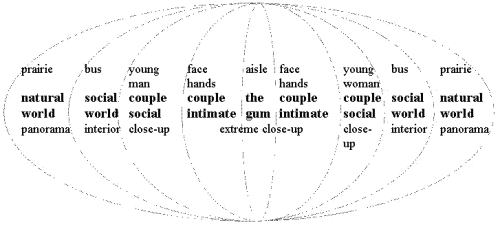
I have been using the world 'aisle' deliberately. The view of the bus is reminiscent of a wedding viewed from the altar: a young man and woman coyly sitting on either side of the aisle, the guests in the pews behind them. (Only the little boy - like a choirboy - is in front of them). The woman immediately behind the young woman is holding a bunch of flowers like a bridesmaid. There are other parallels too. The young man reaches in his pocket for the gum as a groom reaches for the ring. He gives it to her, and it is a symbol of their union. In the final shots, we see an image of joined hands (another symbol of marriage) and also - in the only merged shot of the whole sequence - a transformation in which two become one. (The slow and significant placing of the gum in the mouth suggests both oral sex and the communion service). There is a tension between this image of holy matrimony and the story of a casual pick-up, between a sexual union sanctified by society and one quite outside its institutionalized constraints. The casual nature of the encounter is emphasized by both the words and the period of the song. This clash of the matrimonial and the extra-marital is an image of fascination to the 1980s and 1990s; it is frequently used, for example, in the stage and video performances of Madonna. This ad is... [a] classic example of the product as the bond of love, presented at the centre of a sweeping view of the cosmic, social and sexual world, drawing to it the most powerful American ideological images: the Midwest wheat fields, the plural society, the marriage ceremony, and (if the wheaten-haired woman symbolizes fertility) a marriage of man and harvest, man and mother. All this... [in such a short ad]! If it creates, as I have suggested, a vignette of the American ideology of marriage, then it is interesting to note that the young woman is the one who initiates every stage of the relationship but one. It is she who looks first, who returns half the stick, who shifts her body towards him, who breaks her journey to be with him, while the young man (apart from the one crucial step of offering the gum) is passive. Source: Guy Cook (1992): The Discourse of Advertising. London: Routledge, pp. 49-53
|
Relevant Weblinks

|